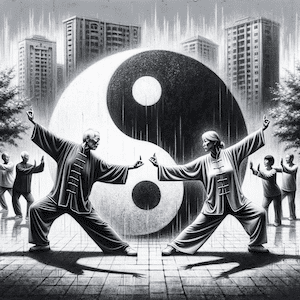
So What Is Tai Chi?
Tai Chi is a gentle form of exercise that originated in ancient China and has been practiced for centuries. It is especially beneficial for older people, as it is low-impact and promotes balance, flexibility, and relaxation. Here are some specific benefits of Tai Chi for older people:
- Improves balance: Tai Chi movements are slow and deliberate, which helps older adults improve their balance and reduce their risk of falling.
- Increases flexibility: Tai Chi involves a range of gentle movements and stretches that can help older adults improve their flexibility and range of motion.
- Reduces stress: Tai Chi is a gentle and meditative exercise that can help older adults reduce stress, anxiety, and depression.
- Low-impact: Tai Chi is a low-impact exercise that puts little strain on joints and muscles, making it ideal for older adults who may have mobility issues or joint pain.
- Improves cardiovascular health: Tai Chi can improve cardiovascular health by increasing circulation and reducing blood pressure.
- Strengthens muscles: Tai Chi involves slow, controlled movements that can help older adults strengthen their muscles and improve their overall fitness.
- Promotes relaxation: Tai Chi is a calming and meditative exercise that can help older adults relax and reduce tension.
Overall, Tai Chi is a safe and effective form of exercise for older adults that can help improve their physical and mental well-being.
What are the different forms of Tai Chi?
There are several different forms of Tai Chi, each with its own set of movements and techniques. Here are some of the most common forms of Tai Chi:
- Yang Style Tai Chi: This is the most popular form of Tai Chi and is characterized by its gentle, flowing movements. Yang Style Tai Chi is a good option for beginners and older adults, as it is low-impact and easy to learn.
- Chen Style Tai Chi: Chen Style Tai Chi is more dynamic and physically demanding than Yang Style Tai Chi. It involves faster movements and more complex techniques, making it a good option for those who are looking for a more challenging workout.
- Wu Style Tai Chi: Wu Style Tai Chi is characterized by its smaller, more compact movements. It is a good option for those who may have mobility issues or who are looking for a low-impact form of exercise.
- Sun Style Tai Chi: Sun Style Tai Chi combines elements of Tai Chi with other martial arts, such as Xingyi and Bagua. It involves a mix of slow, flowing movements and faster, more explosive techniques.
- Hao Style Tai Chi: Hao Style Tai Chi is a relatively new form of Tai Chi that is characterized by its emphasis on internal energy and meditation. It involves slow, gentle movements and is considered to be one of the most meditative forms of Tai Chi.
These are just a few examples of the many different forms of Tai Chi. Each form has its own unique set of movements and techniques, so it’s important to try different styles to find the one that works best for you.
Conclusion
Tai Chi is a wonderful form of exercise for seniors. It offers a range of benefits, from improving balance and coordination to reducing stress and anxiety to improving physical strength and flexibility.
Tai Chi is easy to learn, and the gentle movements can be adapted to match your level of fitness. The slow, fluid motions are easy on your joints and can help improve your balance, posture, and overall physical health.
As an added bonus, Tai Chi is also known to be calming and meditative, offering an emotional boost as well. No matter what your age, Tai Chi can be a beneficial addition to your everyday routine.
How Do I Get Started
There are many resources available for learning Tai Chi in the USA. Here are some options:
Local community centers: Many community centers and senior centers offer Tai Chi classes. These classes are often taught by experienced instructors and are open to people of all ages and fitness levels.
Martial arts schools: Many martial arts schools offer Tai Chi classes as part of their curriculum. These classes are often taught by experienced Tai Chi instructors who are also trained in other martial arts.
YMCA: Many YMCA locations offer Tai Chi classes, often at a reduced cost for members.
Tai Chi organizations: There are several Tai Chi organizations in the USA, such as the Tai Chi for Health Institute and the Tai Chi Association of America. These organizations offer resources such as teacher training programs, workshops, and events.
Online resources: There are many online resources available for learning Tai Chi, such as instructional videos, books, and articles. Some popular websites include Tai Chi for Health Institute, Yang’s Martial Arts Association, and Tai Chi Foundation.
No matter where you decide to learn Tai Chi, it’s important to find a qualified instructor who can guide you through the practice safely and effectively.




